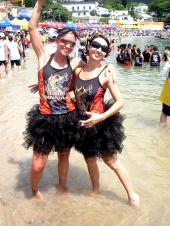Want more reach?
Stretch your LEGS!
The hamstring muscles (in the back of the thigh) are a common restriction to getting more effective reach. Why? Many paddlers adopt a single leg or double leg forward position in the boat. This often requires straightening the knee to brace against the forward foot-stop (under the bench in front). With the hip joint flexed at 90 degrees, this position begins to put tension on the hamstring muscle group. Since the hamstrings originate from the pelvis, putting them under tension will tether the pelvis to resist what biomechanists call anterior pelvic tilt. Since the pelvis is the base for your trunk and upper body, having tight hamstrings limits the amount of forward lean at the hip joint with the lumbar spine and pelvis in neutral posture.
What does all that mean? If you have tight hamstrings (read below), this will limit the amount of reach you have as well as place increased stress on the low back because tight hamstrings will lock down the pelvis and hips, forcing a paddler to flex repeatedly and forcefully through their lumbar spine.

The hamstring’s connected to the…ischial tuberosity…the ischial tuberosity’s part of the…pelvis…the pelvis is connected to the…low back and that’s ana-tomy!
The Role of the Boat
Not all rows in the boat are created equal. In the BuK models we use in the Bay Area, the gunnel and floor follow a parabolic curvature while the benches stay in-plane with the surface of the water. What does this mean for a paddler? The floor slopes down from row 10 to row 5 and then begins to slope upwards from row 5 to row 1. The floor position (and relative height of the bench post) means that for one paddler to move row to row, there will be decreasing tension on the hamstring during reach from row 10 to row 5 and then increasing tension moving from row 5 to row 1.
The parabolic nature of the gunnel will also affect reach slightly because it will restrict or facilitate rotation, but since a majority of reach (but not necessarily power) is obtained from hip flexion this topic will be explored in another article.

A paddler’s dynamic ability to reach is affected by 3 things: core stability, flexibility, and position in the boat
How much flexibility is needed?
On average, males have tighter hamstrings than do females, regardless of age. The measurement is typically performed laying flat on the back and passively raising the testing leg with knee straight until stopped by muscle tightness. Average passive straight leg raise measures for males is 68.5 deg and for females is 76.3 deg (Youdas, et al). Translated to a dragon boat environment, if a paddler were to sit straight up with excellent posture, one or both legs kept straight in front of them, men could only bend forward 68.5 deg while women can lean forward 76.3 deg before being stopped by hamstring tightness. To think of it another way, few adults can (naturally) sit on one bench with their feet propped on the next bench up and hold an upright body position at 90 deg (like an L) due to hamstring tension.
Keep in mind that this measurement is performed with the knee fully straight. In a dragon boat, I believe most adult paddlers of average leg length can sit on the bench and get the ball of their foot or heel on the forward foot-stop with some knee flexion (aka bend). I intend to take some metrics of our BuK boats to point out any discrepancies row to row (but that will have to come later). By having one or both knees flexed, this decreases tension on the hamstring(s) and potentially allows for a paddler to have more hip hinge before the low back begins to flex.
So in theory, a boat full of tall ballet dancers should have incredible reach!

A Word on Stability
Hip hinging forward with a straight back is not all about flexibility. Paddlers will also need good core stability to keep the spine neutral. If a paddler is found to be quite flexible but is seen to “hunch and crunch” during their stroke, it may be that they are lacking muscular stability to control their bodies through their range of motion.
Conclusion
Whether you’re interested in obtaining more reach or developing adequate flexibility to prevent injury, stretching your hamstrings dynamically prior to a workout and statically after a workout is an essential part of your dragon boat dry land training.
References:
Youdas JW, Krause DA, Hollman JH, Harmsen WS, Laskowski E. “The influence of gender and age on hamstring muscle length in healthy adults.” J Orthop Sports Phys Ther. 2005 Apr;35(4):246-52

